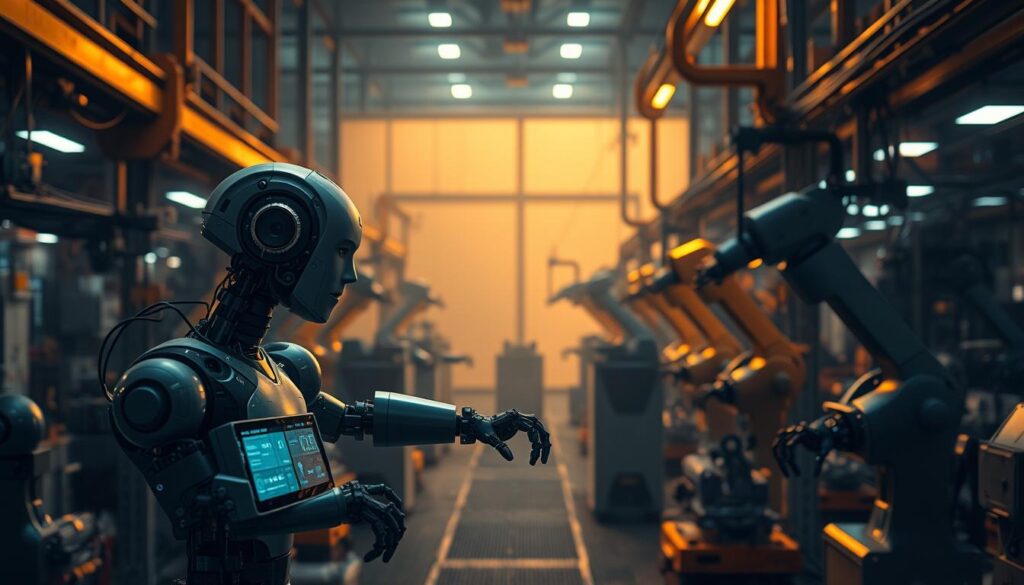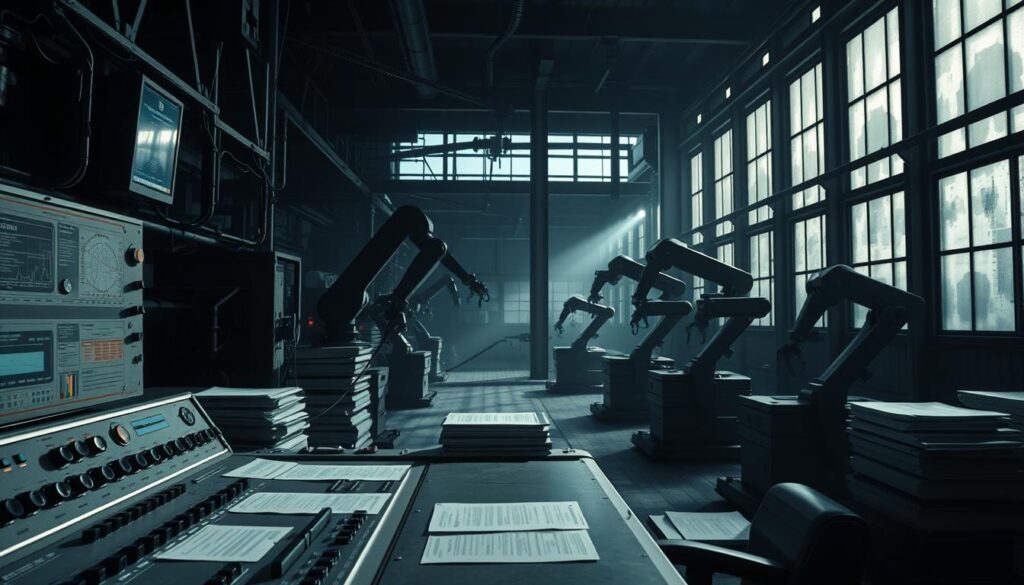The world of industrial robotics is changing fast. Robots are now more advanced, working in fields like manufacturing, healthcare, and farming.
Robots can make decisions on their own. They can understand their surroundings, decide quickly, and do tasks with little help from humans.
But, there are big ethical questions to answer. Robots are very good at their jobs, but they also make us wonder about who’s responsible, safety, and how they might change society.
Artificial intelligence and robots together create a complex situation. It’s where new tech meets important ethics. Experts and leaders need to work together to make sure robots are used wisely.
Creating robots that can act on their own needs careful planning. We must think about the risks and how to use their abilities for good. Rules and guidelines will help shape the future of robots in work.
Understanding the Evolution of AI in Industrial Automation
The world of manufacturing is changing fast thanks to new tech. Artificial intelligence is leading this change, making machines do more than ever before.
New tech is making industrial robots smarter. They can now do things that were thought impossible, like making decisions on their own with great accuracy.
Current State of AI Implementation in Manufacturing
Today, AI is used in many ways in factories:
- Predictive maintenance systems
- Real-time quality control mechanisms
- Adaptive production line optimization
- Intelligent resource management
Key Technological Advances in Robotic Decision-Making
New tech is giving robots better brains. Machine learning lets them understand and act on complex data. This makes them smarter and more efficient over time.
| Technology | Impact | Performance Improvement |
|---|---|---|
| Computer Vision | Enhanced visual inspection | 95% accuracy rate |
| Neural Networks | Adaptive learning | 40% faster decision-making |
| Sensor Fusion | Multi-dimensional data processing | 85% reduced error rates |
Impact on Production Efficiency and Quality Control
Industry 4.0 is making factories work better. Autonomous robots now detect tiny flaws, make production smoother, and cut down on mistakes.
This change is big for factories. It makes them smarter, more flexible, and better at making things.
Safety and Risk Assessment in Autonomous Robot Operations
Industrial robotics has reached a key point where safety is top priority. Now, robotic programming includes advanced risk assessment to protect workers and keep operations safe. The complexity of these robots requires detailed safety measures, more than just mechanical guards.
Robotics engineering services are key in making these safety systems. They create smart safety frameworks that can spot risks before they happen. This is important for keeping workers safe and operations running smoothly.
- Collision avoidance systems with real-time environmental scanning
- Emergency stop mechanisms integrated into robotic control systems
- Advanced sensor networks for complete workspace monitoring
- Predictive risk assessment algorithms
Cybersecurity is also a big part of robot safety. Makers must use strong encryption and secure programming to avoid hacking. The aim is to make robots not just high-tech but also secure.
To reduce risks, safety strategies now use many layers. This includes physical barriers, smart sensors, and advanced software. Together, they create strong protection for robots in industrial settings.
Industrial Robotics Development: Challenges and Opportunities
The world of industrial robotics is changing fast. It brings both big challenges and new chances for robotic process automation. With new tech, companies are finding new ways to make robots change how we make things and offer services.
Integration of Advanced Sensors and Machine Learning
Today’s industrial robots are getting smarter with new sensors and learning machines. These advancements let robots:
- Adjust quickly to new settings
- Make smart choices on their own
- Work more precisely and efficiently
Collaborative Robot Systems
Cobots are a big step forward in robotic automation. They’re made to work with people, making work better and safer. The main benefits are:
- More flexible workspaces
- Less strain on people
- Better work flow
Future Development Trajectories
Robotics companies are looking into new tech to change automation. They’re exploring things like smarter AI, edge computing, and easier ways for humans and robots to work together.
As these techs get better, we’ll see big changes in how we automate industries. It’s an exciting time for robotic process automation.
Privacy and Data Protection in Robotic Systems

Advanced manufacturing robots have changed how we work, but they also bring up big privacy and data protection issues. These smart machines collect a lot of personal info every day. This can be a big risk for both companies and people.
The data these robots collect covers many areas:
- Production performance metrics
- Employee performance tracking
- Manufacturing process details
- Operational efficiency measurements
Companies need to have strong data protection plans to keep this info safe. Encryption, strict access controls, and strong security protocols are key to stopping data leaks.
Important steps for keeping data safe include:
- Building strong cybersecurity systems
- Doing regular security checks
- Following data protection laws
- Being clear about how data is handled
Following the law is very important. Companies using these robots must follow rules like GDPR. This helps protect people’s privacy while using new tech. Finding the right balance between tech and safety is a big challenge today.
Workforce Impact and Labor Market Implications
The world of industrial robotics is changing how we work. Automation brings both challenges and chances for workers in many fields. The old ways of thinking about jobs are no longer valid.
Automation does more than just replace jobs. The World Economic Forum says 24 million new jobs could come from AI and robotics by 2025. This shows a big change in how we work.
Job Displacement Concerns
Automation is changing how we work. In manufacturing and other industrial areas, jobs are being rearranged:
- Robots are taking over simple tasks
- Jobs that don’t need much skill are at risk
- Technology is making jobs change faster
Skills Gap and Training Requirements
With more robots, workers need new skills. They must learn to work with advanced technology. Learning new things and getting better at your job is key to keeping up.
- Learning to program robots
- Being good with digital tools
- Being able to solve complex problems
- Knowing how to work with machines
New Role Creation in Robotics Maintenance
New jobs in robotics maintenance are opening up. These jobs need special skills and knowledge. They mix human talent with new technology.
- Robotics system engineers
- Automation integration specialists
- AI maintenance technicians
- Experts in making processes better with robots
As robotics keeps getting better, workers who are flexible and always learning will do well. They will be ready for the changing tech world.
Legal and Regulatory Framework for Industrial Robots

The fast growth of Industry 4.0 technology has led to important talks about laws for robots. Governments around the world are making detailed rules to handle the big challenges of robots that work on their own.
The European Union is leading the way with the AI Act. This law sorts AI systems into different risk levels. It helps manage the effects of new robot technologies.
- Unacceptable risk: Systems that pose direct threats to human safety
- High risk: Technologies requiring rigorous compliance and documentation
- Limited risk: Systems with minimal possible harm
- Minimal risk: Routine industrial uses with known safety steps
Important things to think about for robot rules include:
- Setting clear rules for who is responsible
- Defining safety standards for robots working alone
- Creating rules for robot choices
- Keeping worker rights in places where robots work
The laws are changing, trying to keep up with new tech and safety needs. Proactive regulatory approaches are key to making sure robots are developed right.
Responsibility and Liability in Autonomous Decision-Making
The rise of autonomous industrial robots has brought up big legal and ethical questions. Robotics engineering services are facing tough questions about who is responsible when AI makes choices in factories.
Modern industrial robotics needs smart ways to figure out who is liable. Companies using robots must deal with complex legal and ethical issues.
Determining Accountability for Robot Actions
Figuring out who is responsible for what robots do involves many people:
- Robot manufacturers
- Robotics engineering services providers
- Industrial deployment companies
- Software programmers
Insurance and Risk Management
| Risk Category | Potential Liability | Mitigation Strategy |
|---|---|---|
| Equipment Malfunction | Manufacturer Responsibility | Comprehensive Product Warranty |
| Programming Error | Software Developer Liability | Rigorous Testing Protocols |
| Operational Misuse | User Company Responsibility | Specialized Training Programs |
Ethical Programming Guidelines
To make robots act ethically, we need:
- Clear decision-making protocols
- Transparent accountability mechanisms
- Predefined safety intervention strategies
- Continuous performance monitoring
The future of industrial robotics depends on developing complete approaches. These must balance tech innovation with responsible use.
Conclusion
Industrial robotics is advancing fast, bringing both great opportunities and big ethical questions. These robots are changing how we make things, pushing tech to new heights. But they also make us think about safety, who’s to blame, and how they affect society.
Dealing with the ethics of these robots needs a team effort. People from all walks of life must work together. They need to create rules that keep tech in check with human values. We must look closely at the risks, like jobs lost, privacy issues, and who’s responsible when robots make choices.
Talking and working together is key to the future of robots in factories. We need clear rules and laws to guide how these robots are used. This way, we can keep moving forward with tech that helps us, not hurts us.
The future of robots in factories depends on us. We must be ready for challenges, talk openly, and make rules that can grow with tech. The journey of robots in making things is just starting. How we handle ethics will shape their impact on us all.

